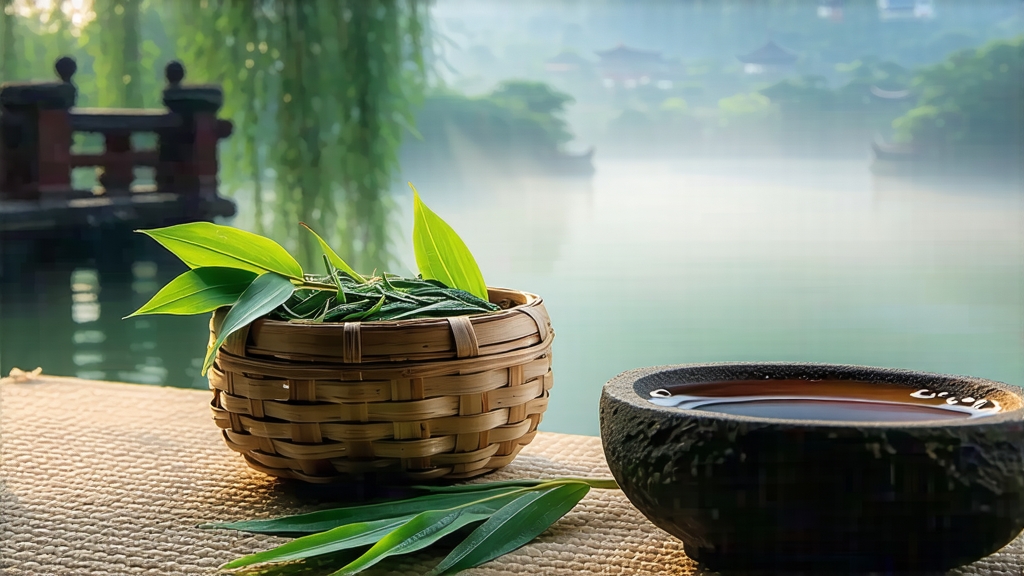
Longjing, literally “Dragon-Well,” is not merely a green tea; it is a living manuscript of Chinese aesthetics, geography, and etiquette. Its fame began in the Tang dynasty, when the monk-poet Lu Yu listed the spring beside Hangzhou’s Lion Peak as one of the nation’s twenty finest water sources. By the Song era, imperial tribute caravans carried the earliest roasted leaves to Kaifeng’s marble courts, and the Qing emperor Qianlong, during his southern inspection tours, allegedly pocketed a handful of shoots from the Hugong Temple bushes, granting them imperial status and the eighteen mother trees that still survive today. Thus, every sip of Longjing is a dialogue with eleven centuries of scholars, emperors, and monks who believed that tea could “wash the dust of the world from one’s heart.”
Geography writes the first chapter of flavor. The West Lake micro-basin is a amphitheater of low hills that trap the East China Sea’s monsoon mist, creating a humid veil that filters sunlight into a soft, diffused glow. The soil is quartz-rich sandy loam, acidic yet laced with sweet mineral springs. Day-night temperature swings of 10 °C during March slow the conversion of amino acids into catechins, preserving the famous umami sweetness called xian. Within this basin, five historic villages argue over primacy: Lion (Shi), Dragon (Long), Cloud (Yun), Tiger (Hu), and Plum (Mei). Each slope tilts at a slightly different azimuth, coaxing divergent aromatics: Lion yields a bean-like creaminess, Dragon a flash of steel-petalled orchid, Cloud a marine breeze, Tiger a roasted chestnut depth, and Plum a lingering honey echo. Purists treat these micro-terroirs like Burgundy crus, blending only within the same lunar day to preserve coherence.
The cultivar itself matters as much as the land. The traditional Longjing Qunti is an open-pollinated landrace with small, thick leaves that tolerate high pan heat without collapsing. In the 1970s, agronomists released Longjing #43, a clonal selection that sprouts five days earlier and offers a showier, jade-green infusion, but can taste thin if over-fired. More recently, the purple-stemmed Zhongcha 102 adds florality yet lacks the signature “pressed sword” shape. Authenticity, therefore, is a negotiation between genetics and geography, not a single pedigree.
Craft turns leaf into legend. The plucking window opens at the spring equinox and closes before Qingming festival; each dawn, pickers—usually women wearing indigo headscarves—search for the standard “one bud with one unfolding leaf,” no longer than 2.5 cm. The harvest must reach the village workshop within two hours, or enzymatic oxidation will erase the jade hue. There, masters perform the tenfold hand-firing ritual on bare cast-iron pans heated to 80 °C, a temperature that blisters fingertips yet must feel like a lover’s caress. They press, shake, buckle, and smooth the leaves in cycles lasting 25 minutes, reducing moisture from 75 % to 5 % without ever allowing the temperature to drop below 60 °C or rise above 90 °C. The motion resembles calligraphy: the palm is the brush, the pan the rice paper, and the curling leaf the ink stroke. When done correctly, each leaf attains the flat, spear shape that can balance on a bed of needles, its edges tinted prairie-gold while the center stays jade. A single master supervises no more than 250 g per batch, ensuring that every leaf hears the same thermal story.
Water chooses its own tea. For Longjing, the ideal is the spring that bubbles beneath Tiger-Running Spring, whose silica content softens the liquor and elongates the finish. Failing that, use low-TDS mountain water brought to 80 °C—never boiling, which coaxes bitter quercetins. Glassware is preferred; the widening conical shape of a 250 ml tumbler allows the leaves to stand like tiny green banners. Use three grams—about a level tablespoon—for every 150 ml. Awaken the leaves with a 20-second rinse, then infuse for 60 seconds. The first pour should be silent: lift the kettle only 5 cm above the rim to avoid bruising. Watch the leaves unfurl in a slow waltz, releasing chlor